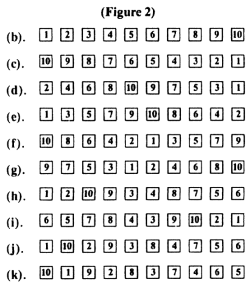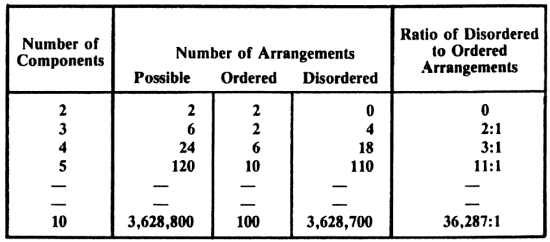One of the strongest direct evidences for special creation is the existence of innumerable highly complex systems in the universe, systems composed of components occurring in a pattern of "order" rather than disorder. Creationists maintain that highly ordered systems could not arise by chance, since random processes generate disorder rather than order, simplicity rather than complexity and confusion instead of "information."
For example, consider a series of ten flash cards, numbered from one to ten. If these are thoroughly and randomly mixed, and then laid out successively in a linear array along the table, it would be extremely unlikely that the numbers would fall out in order from one to ten. Actually, there are 3,628,800 different ways in which these numbers could be arranged, so that the "probability" of this particular ordered arrangement is only one in 3,628,800. (This number is "ten factorial," written as 10!, and can be calculated simply by multiplying together all the numbers from one to ten.)
It is obvious that the probability of such a numerically ordered arrangement decreases rapidly as the number of components increases. For any linear system of 100 components in specified order, the probability is one in 100!, or one chance in 10158 (a number represented by "one followed by 158 zeroes").
A system requiring such a high degree of order could never happen by chance. This follows from the fact that probability theory only applies to systems with a finite possibility of occurring at least once in the universe, and it would be inconceivable that 10158 different trials could ever be made in our entire space-time universe.
Astro-physicists estimate that there are no more than 1080 infinitesimal "particles" in the universe, and that the age of the universe in its present form is no greater than 1018 seconds (30 billion years). Assuming each particle can participate in a thousand billion (1012) different events every second (this is impossibly high, of course), then the greatest number of events that could ever happen (or trials that could ever be made) in all the universe throughout its entire history is only 1080 x 1018 x 1012, or 10110 (most authorities would make this figure much lower, about 1050). Any event with a probability of less than one chance in 10110, therefore, cannot occur. Its probability becomes zero, at least in our known universe.
Thus, the above-suggested ordered arrangement of 100 components has a zero probability. It could never happen by chance. Since every single living cell is infinitely more complex and ordered than this, it is impossible that even the simplest form of life could ever have originated by chance. Even the simplest replicating protein molecule that could be imagined has been shown by Golay1 to have a probability of one in 10450. Salisbury2 calculates the probability of a typical DNA chain to be one in 10600.
However, when creationists use this evidence from probability while lecturing or debating on the creation/evolution question, evolutionists often dismiss the evidence as irrelevant, using the clever and confusing argument that no arrangement is more or less probable than any other arrangement, and some arrangement must exist! (See Figure. 1)
For example, suppose the ten flash cards showed up as follows:
This arrangement obviously is unordered in comparison with the ordered arrangement below:
Nevertheless, the evolutionist will say, the unordered arrangement has the same probability (one in 3,628,800, or 10!) as the ordered arrangement. Consequently, since some arrangement is necessary, and any arrangement is just as probable as any other, there is no reason to see any particular significance in the arrangement which happens to occur. Consequently, any argument for design based on probability, they say, is meaningless.
Superficially, this claim may seem logical, even though we immediately sense that something is wrong with it. We know intuitively, as well as experimentally, that ordered arrangements are much less probable than unordered arrangements. Random arrangements of boulders on a hillside, for example, are "natural," whereas the same boulders arranged in a circle would require explanation.
Closer consideration, of course, does quickly reveal that such evolutionary reasoning is specious. If arrangement (a) had, for some reason, been specified beforehand, then its actual occurrence in the shuffle would indeed have been surprising. It could then no longer be considered an unordered arrangement, since it had been "ordered" externally! But it was not specified ahead of time—it was just the luck of the draw. Arrangement (b), however, has intrinsic order and its actual occurrence, therefore, would almost certainly not have been by chance.
This type of evolutionary equivocation crops up in various guises. One debater responded to the creationists' probability argument by calling attention to the particular combination of people in the audience. With all the people in the state, he noted, the probability that this specific group, rather than some other group, would come together by chance was "extremely small, yet there they were! The answer, of course, was that the group had not come together by chance at all—each person had come by direct intent. Nor had the individuals in the group been prespecified, as would have been the case in a designed system, where each component had to occupy a specific position in order for the system to function.
Once in a while, the objection is a little more subtle. The fact that a certain ordered structure, functioning in a specific way, seems to have an infinitesimal probability of origin by chance is side-stepped by asserting that if some other chance assemblage had come together, it may have functioned in some other way. Evolution might then have taken a different direction. The present functioning system is merely the natural development from the components that happened to come together, and this is no less probable than any other assemblage that might have evolved differently.
But this tenuous argument implicitly assumes that any chance aggregation of particles will contain some amount of "information" and, therefore, will have some kind of evolutionary potential. Such a belief is gratuitous and naive, to say the least, when all real experience indicates the exact opposite. That is, it is far easier and more common to generate something disordered and useless than something organized and functioning.
One cannot simply pull a working system out of a hat full of random particles. The system must possess the requisite "information" before it can get anywhere or do anything constructive. It must be organized in some kind of pattern, and patterns do not usually appear spontaneously. They are not inevitable, as the above evolutionary argument implies, but extremely rare.
For example, although one could arrange the ten flash cards in a number of possible "ordered" patterns, the number is quite limited. There seems to be a certain amount of "information" in each of the arrangements shown below, but it is obvious that arrangements (b) and (c) are more "ordered," containing more information than any of the others. Arrangement (a), as noted earlier, contains no real order or information—it is strictly "random." No doubt a few other arrangements could be devised with a small amount of order to them, but only a few (See Figure 2).

To be generous, however, let us assume that as many as 100 patterns could be devised for the ten cards which would contain some modicum of order. Each of these would have some amount of "information" and therefore, might theoretically be able to specify some sort of wobbly function. This is entirely speculative, of course, since the only one which is known to be functional is the ideal pattern, as defined in arrangement (b).
Even at best, however, there would be only 100 possible functional arrangements, leaving 3,628,700 completely unordered, and, therefore, non-functional arrangements, a ratio of over 36,000 to one. That is, the odds are at least 36,000 to one against any random assemblage of ten components into a meaningful system, which could possibly serve as a base or pattern for anything.
This simple examination merely confirms that which is intuitively obvious anyhow, namely, that disorder in a system is tremendously more probable than any kind of order in that system -- not only one specific pattern, but any kind of pattern! Furthermore, this improbability increases as the number of components in the system increases (See Figure 3).

The number of ordered arrangements shown in the table is somewhat arbitrary, of course, but certainly generous. In any event, it is very clear that the probability of the chance occurrence of any kind of "information" in a system is very small, and that this probability rapidly diminishes as the complexity of the system increases.
This means that, whenever one sees any kind of real ordered complexity in nature, particularly as found in living systems, he can be sure this complexity was designed.
One must conclude that, contrary to the established and current wisdom, a scenario describing the genesis of life on earth by chance and natural causes which can be accepted on the basis of fact and not faith has not yet been written.3
I believed we developed this practice (i.e., of postulating prebiological natural selection) to avoid facing the conclusion that the probability of a self-replicating state is zero… When for practical purposes the concept of infinite time and matter has to be invoked, that concept of probability is annulled.4
There is still one other evolutionary equivocation to be noted, however. What chance cannot accomplish, evolutionists glibly attribute to natural selection.
So natural selection as a process is okay. We are also pretty sure that it goes on in nature although good examples are surprisingly rare. The best evidence comes from the many cases where it can be shown that biological structures have been optimized—that is, structures that represent optimal engineering solutions to the problems that an animal has of feeding or escaping predators or generally functioning in its environment ...The presence of these optimal structures does not, of course, prove that they developed through natural selection, but it does provide strong circumstantial argument.5
This is a rather typical example of the way evolutionists bypass even the strongest evidences for design. Dr. Raup, with his doctorate from Harvard, is a highly competent geologist, serving as Curator of Geology at Chicago's great Field Museum, and formerly as Professor of Geology at the University of Rochester. He candidly acknowledges the complete absence of transitional forms in the fossil record and the complete absence of evidence for observable progressive evolution.
Instead of finding the gradual unfolding of life, what geologists of Darwin's time, and geologists of the present day actually find is a highly uneven or jerky record; that is, species appear in the sequence very suddenly, show little or no change during their existence in the record, then abruptly go out of the record. And it is not always clear, in fact it's rarely clear, that the descendants were actually better adapted than their predecessors. In other words, biological improvement is hard to find.6
Thus, in spite of the utter lack of evidence in either living populations or the fossil record that natural selection ever generates higher orders of complexity (or "biological improvement," or "better adaptation") the mere existence of "optimal structures" is taken by evolutionists as confirmation of the remarkable power of natural selection!
But, of course, such a process as natural selection does not even exist at the prebiological level! Whatever effect selection may possibly have had on random processes in later biological reproduction, it is clear beyond any rational argument that chance processes could never have produced even the simplest forms of life in the first place. Without a living God to create life, the laws of probability and complexity prove beyond doubt that life could never come into existence at all.
REFERENCES
1 Marcel Golay, "Reflections of a Communications Engineer," Analytical Chemistry, V. 33, June 1961, p. 23.
2 Frank B. Salisbury, "Doubts about the Modern Synthetic Theory of Evolution," American Biology Teacher, September 1971, p. 336.
3 Hubert P. Yockey, "A Calculation of the Probability of Spontaneous Bio-genesis by Information Theory," Journal of Theoretical Biology, V. 67, 1977, p. 398.
4 Peter T. Mora, "The Folly of Probability," in The Origins of Prebiological Systems (Sydney Fox, Editor, New York, Academic Press, 1965), p. 45.
5 David M. Raup, "Conflicts Between Darwin and Paleontology," Bulletin of the Field Museum of Natural History, V. 50, January 1979, pp. 25-26.
6 Ibid., p. 23.
* Dr. Henry M. Morris is Founder and President of the Institute for Creation Research.













